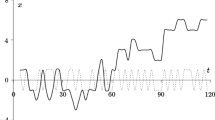Abstract
We consider the minimax setup for the two-armed bandit problem as applied to data processing if there are two alternative processing methods with different a priori unknown efficiencies. One should determine the most efficient method and provide its predominant application. To this end, we use the mirror descent algorithm (MDA). It is well known that the corresponding minimax risk has the order of \( N^{1/2} \), where \( N \) is the amount of processed data, and this bound is order sharp. We propose a batch version of the MDA which allows processing data by packets; this is especially important if parallel data processing can be provided. In this case, the processing time is determined by the number of batches rather than the total amount of data. Unexpectedly, it has turned out that the batch version behaves unlike the ordinary one even if the number of packets is large. Moreover, the batch version provides a considerably lower minimax risk; i.e., it substantially improves the control performance. We explain this result by considering another batch modification of the MDA whose behavior is close to the behavior of the ordinary version and the minimax risk is close as well. Our estimates use invariant descriptions of the algorithms based on Gaussian approximations of income in the batches of data in the domain of “close” distributions and are obtained by Monte-Carlo simulation.












Similar content being viewed by others
REFERENCES
Borovkov, A.A., Matematicheskaya statistika. Dopolnitel’nye glavy: Uchebnoe posobie dlya vuzov (Mathematical Statistics. Additional Chapters: a Textbook for Universities), Moscow: Nauka, 1984.
Varshavskii, V.I., Kollektivnoe povedenie avtomatov (Collective Behavior of Automata), Moscow: Nauka, 1973.
Gasnikov, A.V., Nesterov, Yu.E., and Spokoiny, V.G., On the efficiency of a randomized mirror descent algorithm in online optimization problems, Comput. Math. Math. Phys., 2015, vol. 55, no. 4, pp. 580–596.
Kolnogorov, A.V., Gaussian two-armed bandit and optimization of batch data processing, Probl. Inf. Transm., 2018, vol. 54, no. 1, pp. 84–100.
Kolnogorov, A.V., Gaussian two-armed bandit: limiting description, Probl. Inf. Transm., 2020, vol. 56, no. 3, pp. 278–301.
Nazin, A.V. and Poznyak, A.S., Adaptivnyi vybor variantov (Adaptive Choice of Options), Moscow: Nauka, 1986.
Nemirovskii, A.S. and Yudin, D.B., Efficient methods for solving high-dimensional convex programming problems, Ekon. Mat. Metody, 1979, vol. 15, no. 1, pp. 135–152.
Presman, E.L. and Sonin, I.M., Posledovatel’noe upravlenie po nepolnym dannym (Sequential Control Based on Incomplete Data), Moscow: Nauka, 1982.
Smirnov, D.S. and Gromova, E.V., Decision-making model under presence of experts as a modified multi-armed bandit problem, Mat. Teor. Igr Pril., 2017, vol. 9, no. 4, pp. 69–87.
Sragovich, V.G., Adaptivnoe upravlenie (Adaptive Control), Moscow: Nauka, 1981.
Tsetlin, M.L., Issledovaniya po teorii avtomatov i modelirovaniyu biologicheskikh sistem (Research on Automata Theory and Modeling of Biological Systems), Moscow: Nauka, 1969.
Auer, P., Using confidence bounds for exploitation-exploration trade-offs, J. Mach. Learn. Res., 2002, vol. 3, pp. 397–422.
Auer, P., Cesa-Bianchi, N., and Fischer, P., Finite-time analysis of the multi-armed bandit problem, Mach. Learn., 2002, vol. 47, no. 2–3, pp. 235–256.
Bather, J.A., The minimax risk for the two-armed bandit problem, in Mathematical Learning Models—Theory and Algorithms, Lect. Notes Stat., New York: Springer-Verlag, 1983, vol. 20, pp. 1–11.
Berry, D.A. and Fristedt, B., Bandit Problems: Sequential Allocation of Experiments, London–New York: Chapman and Hall, 1985.
Fabius, J. and van Zwet, W.R., Some remarks on the two-armed bandit, Ann. Math. Stat., 1970, vol. 41, pp. 1906–1916.
Juditsky, A., Nazin, A.V., Tsybakov, A.B., and Vayatis, N., Gap-free bounds for stochastic multi-armed bandit, Proc. 17th World Congr. IFAC (Seoul, Korea, July 6–11, 2008), pp. 11560–11563.
Kaufmann, E., On Bayesian index policies for sequential resource allocation, Ann. Stat., 2018, vol. 46, no. 2, pp. 842–865.
Lai, T.L., Levin, B., Robbins, H., and Siegmund, D., Sequential medical trials (stopping rules/asymptotic optimality), Proc. Natl. Acad. Sci. USA, 1980, vol. 77, no. 6, pp. 3135–3138.
Lattimore, T. and Szepesvari, C., Bandit Algorithms, Cambridge: Cambridge Univ. Press, 2020.
Lai, T.L. and Robbins, H., Asymptotically efficient adaptive allocation rules, Adv. Appl. Math., 1985, vol. 6, pp. 4–22.
Lugosi, G. and Cesa-Bianchi, N., Prediction, Learning and Games, Cambridge: Cambridge Univ. Press, 2006.
Robbins, H., Some aspects of the sequential design of experiments, Bull. AMS, 1952, vol. 58, no. 5, pp. 527–535.
Vogel, W., An asymptotic minimax theorem for the two-armed bandit problem, Ann. Math. Stat., 1960, vol. 31, pp. 444–451.
Funding
The research by A.V. Nazin was supported financially by the Russian Science Foundation, project no. 16-11-10015. The research by A.V. Kolnogorov and D.N. Shiyan was supported financially by the Russian Foundation for Basic Research, project no. 20-01-00062.
Author information
Authors and Affiliations
Corresponding authors
Additional information
Translated by V. Potapchouck
Rights and permissions
About this article
Cite this article
Kolnogorov, A.V., Nazin, A.V. & Shiyan, D.N. Two-Armed Bandit Problem and Batch Version of the Mirror Descent Algorithm. Autom Remote Control 83, 1288–1307 (2022). https://doi.org/10.1134/S0005117922080100
Received:
Revised:
Accepted:
Published:
Issue Date:
DOI: https://doi.org/10.1134/S0005117922080100




